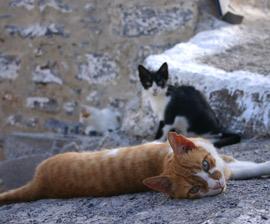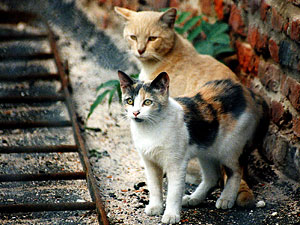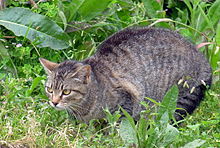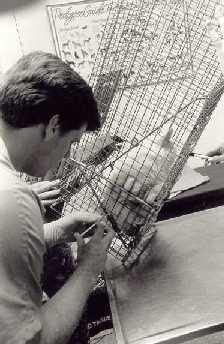Carole's Ferals
A heart of Gold
She is the Angel of roughly 200 feral cats spread across her neighborhood and as far as she can afford to drive; living in multiple colonies and cared for mostly by her. And by a few she convinced to do so or enlisted for help. She can be convincing when she wants to be; and if you do wrong towards an animal, you can light up a fire of angry flames consuming those neglecting and abusing the weak! She is fiercely loyal to her charges and will go an extra mile to care for them; or maybe an extra hundred if it is necessary.
To ensure that her reach goes further than what she can afford to cover, we sat together and worked out some tips and tricks she hopes will help others start or continue successful feral cat programs.
I have never seen somebody as dedicated as her when it comes to the unwanted; Carole's Ferals!

Feeding Feral Cats
Carole is very specific about what she feeds her feral cats. They are living outside and need every ounce of food to count. Food is often spares unless a caring individual steps up and helps them out. But being dependent on multiple people also brings some obstacles with it that need to be considered. And no, cats can't take care about themselves like we may want to believe when irresponsible people dump them. While they may find plenty of food on a farm or in the country, if they learned to hunt, city life is full of dangerous and lacks the food sources needed for survival.
Due to the lack of food feral cats often experience, Carole does not use any Diet food. These cats are rarely overweight, unless they are part of her colony; and it often amazes me how well taken care of they are!
Another food she doesn't use is No Grain or any other special food like it. Like dogs and other animals, cats' stomachs don't do well with constant changes of diets. Changing them from food to food is already rough on them and adding the change from Grain to No Grain would make it even harder on their too often empty stomachs. Avoid switching food, if it is possible!
While the food doesn't have to be high-end, avoid using some of the cheap food that is totally un-nutritional. Quite a few companies producing those type of 'cheap' foods have been under fire and forced to recall their food. Why feeding something that has no nutritional value!?
Don't feed canned food alone. If you check the ingredients you will see that it is often made out of 80% water and thus has very little nutritional value. Canned food is great for trapping and giving medications, but as a food by itself it is worthless.

So what if they are sick?
Feral cats don't get regular vet visits from those that dumped them. So if they get sick, who cares?
If you are one of those Angels that can't just look away, here are some things you can do:
- Dewormer
Dewormer is something that feral cats need as much as house cats. Since you can't just grab them and give it to them, you have to get a bit creative. The best way to get naturally distrusting ferals to eat it is with food they love; canned food and other creations they don't get that often.
Carole uses a broad spectrum dewormer that covers all three major worms (Hook Worms, Tape Worms, Round Worms) such as Happy Jack, that you can buy at any pet store or farm store.
- Antibiotics
If you see that they seem to have snoty noses and such, sometimes you can help them out by giving some Antibiotics such as Clavamox. Like the dewormer you can mix it with canned food or something else they like well.
If it is something that requires hands-on or above your knowledge and skills, you have no choice but to trap them!

Trapping an unwilling Participant!
If you don't have traps, you can rent or borrow them from your local SPCA or Humane Society. But if you are in for the long run, Home Depot for example has them on sale occasionally for roughly $28 for two traps. Or you can check your local newspapers or classified ads.
The trick is to lure the cat into it. Carole's cats are well trained and understand a look or hand signal to know when to back up. They are also familiar with traps and her.
When she does start with new cats or those very distrusting, she often leaves the trap there for longer periods of time to get them used to it.
When she gets ready to trap them, she places some canned food on a newspaper or piece of cardboard on the ground and places the trap on top of it. A good trap will not allow the cats to go 'fishing' for the food, but you can also help that out. It is important that the food is placed where the cats have to trigger the trap. Otherwise you will have to get creative with string and make sure you find a good hiding spot; having to wait for the cat to get into the trap and trigger it yourself.
Don't ever leave a trap unattended. Especially not in very cold or very hot temperatures. Feral cats tend to stress out when trapped and you don't want it to injure itself. A angrily fighting cat in a trap will also warn the others that the metal cage they see is a danger!
It helps to not feed the cats for roughly two days before trapping, since it makes them hungrier and more willing to get into the trap.
When you are getting ready to trap, set up your trap and follow the rule: 'Set it and forget it!' The more often you show yourself around it, the more distrusting the cats will become. You can watch from a safe distance, but don't get too close or do anything that will be out of the ordinary and make them stay in safe distance.
Carole believes that if every county citizen would set one trap, he/she would end up with a cat in it. Until people stop dumping their unwanted animals and become smarter about spaying/neutering, there will be too many homeless animals such as the 'unwanted' ferals!

'Fixing' the 'Problem'
A lot of organizations have special spay/neuter programs for feral cats. Some even will do the trapping for you. But if you had to do it on your own, trap the kitty about a day or two before your spay/neuter appointment.
Cover the trap with a sheet or towel and leave it in a quiet corner. They are not used to being handled and will stress out easily. Stress causes all kinds of health problems in cats. Keep in mind the current weather conditions and don't leave them outside in the trap when it is too cold or too hot.
You can push a litter box underneath the trap to keep the cat from having to sit in a 'mess'. But you never want to remove the cat from the trap unless absolutely necessary.
It may be necessary to have the cat's ear 'tipped' to ensure that you can tell which cat has been done and which hasn't. I personally prefer minor tips that will not butcher the cat's natural beauty. I had a feral cat once who's one ear had been almost completely removed. It looked horrible and was always full of dirt. Besides, their ears have a certain function that helps them survive!
Do not give the cat food or water until it is completely awake. When you think the cat is awake, give it water first and wait with the food until 30 min after the cat had something to drink. Only give it about half of a normal portion.
Males can be released relatively soon after surgery, but Carole keeps the females for at least 24 hours. When you get ready to release them, release them at feeding time. Allow the other cats to get reaquointed with the cat in the cage and then let it out when everybody is eating. Make sure to check for 3-4 days after surgery to ensure the cat is doing alright.

Relocating a smart creature!
To relocate a adult cat is probably wasted time. These intelligent felines have a homing instinct that can lead them miles and miles back to a place they feel comfortable with. This is the reason why Carole rarely relocates cats over a year old; unless they are in grave danger.
When you do have to move them, try to move a few of them at the time. It will make it easier for them to adjust to changes and the 'friends' and 'family' may make them less willing to move back to the old place.
When you trapped a cat/cats for relocation, make sure to keep the stress down. After arriving at the new location, ensure to keep the cat/cats confined for at least a week to get them accustomed to the new surroundings. Preference would be a large crate or something on a porch (to protect them from critters and lose dogs) or somewhere near the new colony. From begin on they should be made used to a schedule; or the old schedule kept up. It will help them adjust and let them know when it is time to eat/look for food.
Most cats will adjust well to new surroundings if given the chance to get used to it.
When it becomes necessary to 'thin out' a colony, euthanizing kittens is not necessary; but rather cruel and a waste of life! These cats did not chose to become homeless and feral; the choice was made for them.
Kittens can often be easily tamed with a little care and patience. I have had semi-feral adult cats in my house that eventually became 'sold' by a few packs of hot dogs, patience and lots of love and respect. A little effort can go a long way and the results are amazing.
Nothing is more rewarding than earning the trust of a creature that has more than enough reason to fear humans. And especially young kittens of just a few weeks can easily become tame and loving.
Love and Respekt
These beautiful creatures, once valued by the Egyptians, did not chose to become homeless. They are feral because they or their ancestors were dumped as unwanted with a wide variety of pathetic excuses. And human nature taught them to fear those that often cause them harm or even death.
They are not the sick pests they are made out by those that do not educate themselves before speaking about something they don't know much about. They are creatures that have to go through great length to survive.
When you have the chance to watch a feral cat colony, you can see and experience the deep care they often have for eachother; a trade I wished many times I could see more often in humans.
It doesn't take much to 'fix' the problem. Death is their constant companion and very few reach old age. Trapping them, fixing them and releasing them allows the control of the population and allows them to strive and live a life they didn't chose, but live so well.
And with a little care and respect, strive they will!
I have met many members of Carole's Ferals and all looked as well or better than many house cats I have seen. Of the 200 cats she cares for, most were fixed in the last year since she started her aggressive attack on unfixed animals. Imagine the work involved in trapping, fixing and caring for 200 cats that are rather unwilling and uncooperative! And have them looks so well that you could use almost any as a example on how a well taking care of cat should look like!
She knows them all by name and her helpers know their colonies. If a new one shows up, she gets a call or a visit; and goes out on a mission! She knows exactly how many she has left to trap; and the traps are already loaded on her old truck! And if one of them is in need of help, Carole is right there to provide a love and respect very few can match!
Nobody will ever love them like she does! They are ...'Carole's Ferals'!
Related Articles
- Six months worth of cats
Feral Cats are unwanted; to no fault of their own. But rather than doing something for them or about the 'problem', we tend to look away or try to chase 'it' off with a rock or a stick. But there are people that won't give up and single-handidly have - Greensboro Cats Examiner - Cats | Examiner.com
Get the latest news and information on Greensboro Cats, including local information on Cats.
Trap - Neuter - Return
Feeding Feral Cats at IBMC with Rev. Kusala
Cats for Adoption, Petfinder.com
- Pet Search Results: Adoptable Cat Pets in Raleigh, NC: Petfinder
Pets in adoption centers near Raleigh, NC are listed on Petfinder, which has helped find homes for over 12 million pets since 1995.




